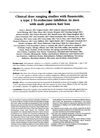TLDR Finasteride effectively treats BPH by reducing prostate size and improving symptoms.
Finasteride was found to be effective in treating benign prostatic hyperplasia (BPH) by inhibiting the conversion of testosterone to dihydrotestosterone. In a double-blind, placebo-controlled study involving 707 patients over 2 years, finasteride significantly improved symptoms, reduced prostate size, and increased urine flow rate. Side effects were generally mild, and the study concluded that finasteride could reverse the natural progression of BPH.
 23 citations
,
January 1998 in “Urological research”
23 citations
,
January 1998 in “Urological research” Castration and finasteride lower urinary oxalate in male rats, potentially treating urolithiasis.
 December 2023 in “International Journal of Biomedicine”
December 2023 in “International Journal of Biomedicine” Topical finasteride might help with male hair loss with fewer side effects than pills, but more research is needed.
 46 citations
,
October 1999 in “Journal of The American Academy of Dermatology”
46 citations
,
October 1999 in “Journal of The American Academy of Dermatology” Finasteride effectively treats male pattern hair loss with a 1 mg daily dose.
 25 citations
,
January 2006 in “British Journal of Dermatology”
25 citations
,
January 2006 in “British Journal of Dermatology” Finasteride lowers scalp and blood DHT levels, potentially treating male-pattern baldness.
 3 citations
,
October 1995 in “International Journal of Dermatology”
3 citations
,
October 1995 in “International Journal of Dermatology” Finasteride helps treat skin issues like acne and baldness by blocking testosterone conversion.
 July 2023 in “Journal of Drug Delivery Science and Technology”
July 2023 in “Journal of Drug Delivery Science and Technology” Finasteride niosomes were developed and found to be effective in treating hair loss, with better results than commercial minoxidil, and could be a promising topical treatment for hair loss.





